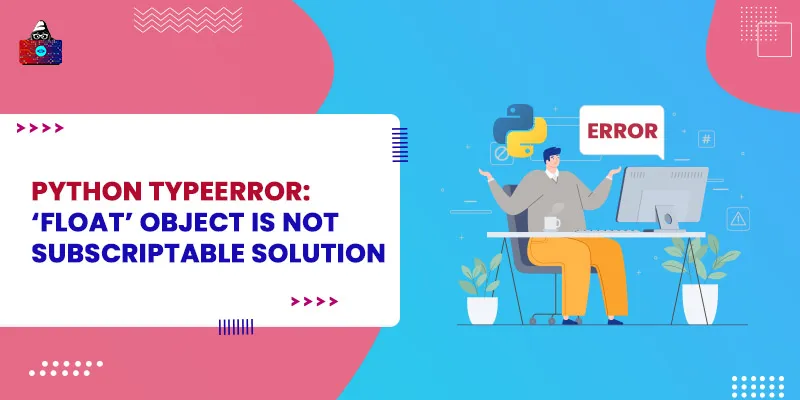Python has three subscriptable objects
list
,
string
, and
tuples
. They are subscriptable because all these objects support indexing to access their elements or items. But Python objects like
float
does not support indexing and are non-subscriptable objects.
If we perform indexing to access any float value, we will receive
TypeError: 'float' object is not subscriptable
error in Python.
In this Python guide, we will walk through the above error and discuss how to solve it. We will also discuss a common example where many new Python learners encounter this error.
So now, let's get started.
Python Error - TypeError: 'float' object is not subscriptable
When we use square brackets to access a float-type object using index numbers, we encounter the error
TypeError: 'float' object is not subscriptable
.
It is divided into two parts Error Type and Error Message.
-
Error Type
(
TypeError): TypeError occurs in Python when we perform an invalid operation on a Python data type object. -
Error message (
'float' object is not subscriptable): This error message tells us we are accessing a floating-point value or variable as a subscriptable object. And it generally occurs when we use indexing on a floating-point number.
Example
>>> #floating point number
>>> float_num = 34.8
>>> #using indexing on the float number
>>> float_num[0]
Traceback (most recent call last):
File "<stdin>", line 1, in <module>
TypeError: 'float' object is not subscriptable
Common Error Scenarios
Let us discuss some common scenarios where you can encounter this error.
Scenario 1: Accessing an Item from a Float
Many new Python learners mistake the indexing operation of the string, list, and tuple with float numbers when they need to solve problems like extracting the first or last digit from a floating-point number.
Example
#floating point number
float_num = 3453.97
#access first digit of the floating number using indexing
first_digit = float_num[0]
print(first_digit)
Output
Traceback (most recent call last):
File "main.py", line 5, in <module>
first_digit = float_num[0]
TypeError: 'float' object is not subscriptable
Break the code
In the above example, we get this error because we tried to access the floating-type variable's
float_num
first digit using indexing, which is invalid in Python. We can not perform indexing on a floating-point number. That's why Python threw the error
'float' object is not subscriptable
.
Solution
To solve the above problem, we first need to change the floating-point number to a string to get the first digit using indexing. Then we will convert that first digit number back to an integer number using the Python int() function.
#floating point number
float_num = 3453.97
#convert the float to string
str_num = str(float_num)
# access the first digit using indexing
first_digit = str_num[0]
# convert the firt digit string value back to integer
first_digit = int(first_digit)
print(f"The first digit of {float_num} is: {first_digit}")
Output
The first digit of 3453.97 is: 3
Scenario 2: Replacing Multiple Items
Python list supports slicing, which returns a new list of a few items from the original list. When we want to replace multiple items in a list, slicing comes in handy.
Example
price = input("Enter the price of the pen: ")
pen = [2.50, 2.75, 1.80, 1.75, 2.60]
pen[0][1][2][3][4] = [float(price)] * 5
print(pen)
Output
Enter the price of the pen: 6
Traceback (most recent call last):
File "/home/main.py", line 3, in <module>
pen[0][1][2][3][4] = [float(price)] * 5
TypeError: 'float' object is not subscriptable
Break the Code
In the above example, we tried to update the items in the list
pen
at once using the value entered by the user. However, in line 3, we used the incorrect syntax. The indices should be separate operations rather than a single chained operation. When the code tries to change the values in the pen list, we receive the error
TypeError: 'float' object is not subscriptable
.
The above code tries to retrieve the values at the index positions [0], [1], [2], [3], and [4]. But these values exist in the float type in our list, which is the cause of the error.
To resolve this, one of the solutions is to use slicing.
Let us write the correct code to get the desired output.
Solution
price = input("Enter the price of the pen: ")
pen = [2.50, 2.75, 1.80, 1.75, 2.60]
pen[0:5] = [float(price)] * 5
print(pen)
Output
Enter the price of the pen: 4
[4.0, 4.0, 4.0, 4.0, 4.0]
Wrapping Up!
The Python
‘float’ object is not subscriptable
Error is a TypeError that occurs when we try to access a floating-point number using indexing. Only Python lists, tuples, and string support indexing, and primitive values like int and float throw an error when we perform indexing on them.
We hope the above article has helped you understand the error in detail. Analyze the above example scenarios to get a clear idea of when the error occurs and how to resolve it. If you encounter the same error and are unable to resolve it, comment down your code, and we will help you with debugging.
People are also reading:
- Python NameError name is not defined Solution
- Python TypeError: unsupported operand type(s) for -: ‘str’ and ‘int’ Solution
- Python IndexError: tuple index out of range Solution
- Python SyntaxError: ‘return’ outside function Solution
- Python SyntaxError: positional argument follows keyword argument Solution
- Python TypeError: unhashable type: ‘slice’ Solution
- Python AttributeError: ‘NoneType’ object has no attribute ‘append’Solution
- Python TypeError: can only concatenate str (not “int”) to str Solution
- Python indexerror: list index out of range Solution
- Python typeerror: ‘list’ object is not callable Solution




